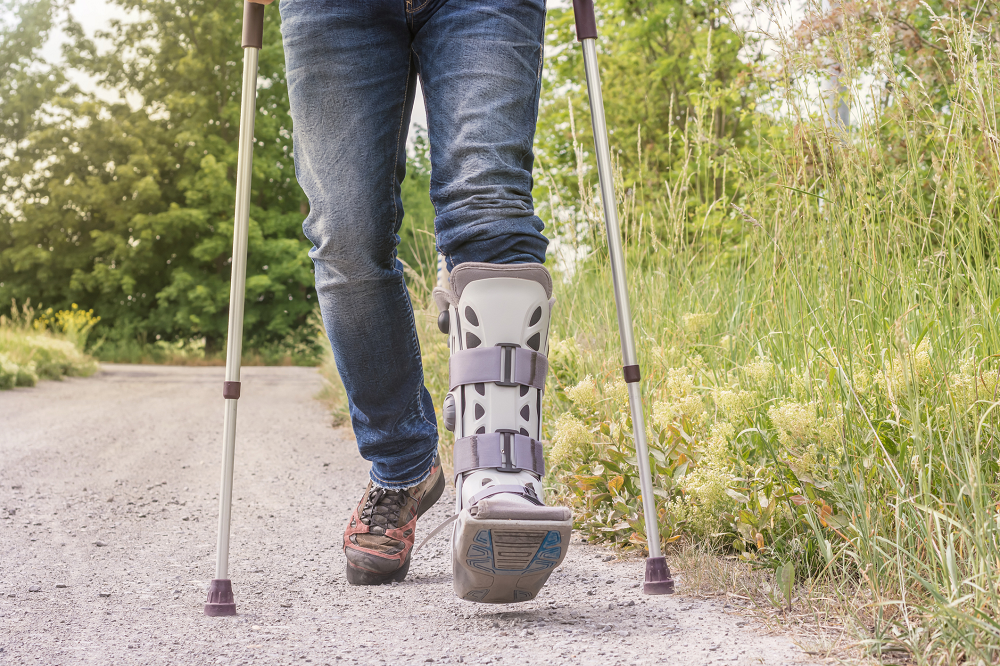
Can you Still Lose Weight when Injured?
What happens when you’re in the middle of your weight loss journey and you suddenly get an injury? It could be a broken fracture, a sprain, a torn ligament or tendon that prevents you for exercising for a few weeks.
Or worse still, it could be an injury requiring surgery meaning none of your usual exercise for months.
Does it mean the end to your weight loss?
The simple answer is ‘no’ – with a little effort, you can continue to lose weight through your recovery.
It’s a Balancing Act
It’s not just your body that you need to keep balanced after an injury. Understandably, many clients panic when they can’t exercise as they worry about where all those calories they usually burn are going to go. But there’s no need to worry too much because the experts tell us that, “Exercise is not part of the weight-loss formula,” according to Wendy Scinta, MD and President-elect of the Obesity Medicine Association. “Weight loss is all about what goes into your mouth.” In other words, if you take in fewer calories than your body needs to just function (even with little movement), you should still lose weight.
This may seem like a conflicting message, but what we are actually saying is that, although exercise is preferable, it’s not absolutely necessary. Exercise won’t technically drop the number on the scale (without concentrating on diet), but it can help you look slimmer, since muscle is denser than fat. Plus exercise will speed up your resting metabolic rate, meaning you burn slightly more calories while you sleep. That and the fact that it contributes to your overall health means people who regularly exercise hate the idea of not being able to do their usual regime, but sometimes it just can’t be helped and we need to come up with plan B.
Putting Plan B into Action
The focus is now solely on your food. Make it count. Follow our tips to ensure you don’t over consume calories while in the recovery stage of your injury. Also, consider how many calories you used to burn each day through exercise and see if you can cut that from your diet. It may not be as much as you think – for instance, a one-hour walk may just burn roughly 250 calories each day so you don’t have a huge amount to cut. Cutting out that glass of wine or the small bar of chocolate in the evening might just be enough to do it.
- Chew your food thoroughly and slow down: we’re always saying it, but it counts now more than any time. And now you’ve no excuse because, for once, you’re not rushing anywhere! Also don’t be afraid to snack in between meals – just choose your snacks wisely (ideally they should be a source of lean protein or vegetables/fruit with protein).
- Use smaller plates: if you haven’t switched down to a smaller plate already, try it now as an incredibly effective way to downsize your portions.
- Eat protein at every meal: again, we’re like a broken record but this is really crucial. Adequate protein will help prevent muscle loss that can result from inactivity. We need protein to help build and repair muscle, skin, and other body tissues. When you have a wound that’s healing, think of food as medicine.
- Store unhealthy foods out of sight: your wife, husband, partner or kids might still insist that there’s chocolate and ‘goodies’ in the house but they’re not for you. Have alternatives to hand for your own ‘treat’: protein bars, homemade protein balls, a small bag of popcorn or a few squares of 80% dark chocolate from time to time.
- Drink water regularly: drink throughout the day, as being hydrated is an important part of the metabolic process in your body, but also dehydration can be mistaken for hunger often. Try to limit your intake of sugary, calorie-laden beverages and stick to water instead.
- Fill up on fibre: you’re likely to be spending more time than usual confined to your bed or couch, so make sure to stock the kitchen with healthy, fibre-filled foods such as lots of vegetables (carrots with hummus is a great snack option), olives, nuts (particularly walnuts and almonds), chickpeas, lentils and beans (great for making soups or dhals with).
- Try to keep moving: okay, so you don’t have full mobility in your arms or your legs, but that doesn’t mean you give up on exercise altogether. See below some tips for exercise when injured. One study published in the Journal of Orthopaedic Trauma even showed that walking on crutches can significantly up the calorie burn for patients since it is considerably more strenuous than normal walking.
Don’t Give up on Exercise!
Even when you are compromised in terms of mobility, there are still exercises that are entirely possible. These will not only help with your recovery and help to burn a few extra calories, but they will also contribute significantly to your mental health, which is important given the challenges that being injured can present (such as lack of independence, lack of social contact or boredom).
Exercise on crutches: although there are some things you can’t do, and some things that you shouldn’t, being non-weight bearing doesn’t mean you can’t stay relatively fit and still exercise. You can even work up to using your crutches for cardiovascular exercise. You may find at first that the effort in your shoulders and arms feels too strenuous, so work in fits and spurts, walking for 30 seconds or a minute, followed by a short break, then another bout of activity. Check out this pdf for advice on how to exercise while on crutches.
Water-based exercise: If your doctor okays it, you may even be able to swim. If you have a cast, you will either have to wear a cover or get a waterproof, airtight item to go over it. The good part about working out in the water is that the buoyancy of water helps support your body weight, taking the pressure off joints. This makes swimming and other water-based activities good choices for people who have to be non-weight bearing. Physical and occupational therapists often use the natural properties of water to help their patients speed up recovery, minimize the loss of range of motion (especially important when the injury is located in a joint), increase blood circulation and decrease inflammation.
Free weights at home: To keep your arm or leg muscles firm (whichever are still fully operational), you could use resistance bands or weights to do arm curls or leg lifts (you can pick up a relatively cheap set of weights in Argos). Another great general exercise is wall pushups. Standing on your good leg a little more than an arm’s length away from the wall, push your body back and forth against the wall. Another simple exercise is using a tennis ball for squeezing exercises to keep your forearms trim, or tricep dips on a chair while watching TV.
Physiotherapy and core strength: You may be doing physio as part of your recovery. Your physio will help you use your muscles in the correct manner to restore yourself to full mobility throughout the recovery process. But also ask them about general exercises – such as core exercises – that you can do to help maintain some muscle tone during your recovery.



